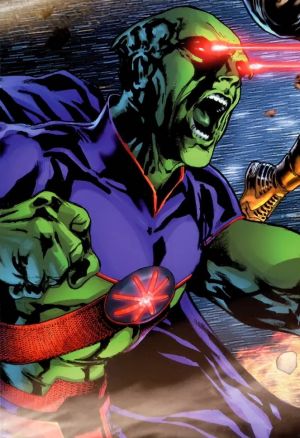Comics /
Spotlight /
Knowledge and Scholarship
The Martian Manhunter as Georg Simmel’s Stranger
By Hervé St-Louis
July 1, 2013 - 13:53
In 1908, German sociologist and philosopher Georg Simmel wrote a short article called ‘The Stranger.’ In ‘The Stranger,’ Simmel conceptualized the phenomenon of the stranger in society. Simmel argues that the stranger is neither a wanderer nor an outsider. The stranger lives with a group he has adopted. He is part of that group but not of that group. His origins come from elsewhere. This affords the stranger a unique vantage point on the society he has joined, often as a confidante, often as an objective judge. I argue in this article that DC Comics’ Martian Manhunter, as a fictional figure is a stranger similar to the archetype originally enunciated by Simmel.
The Martian Manhunter is a super hero created in 1955 in
Detective Comics #225. Writer Joseph Samachson and artist Joe Certa have been credited as his creators. Originally brought to Earth accidentally by physicist Doctor Saul Erdel through a telescopic ray projected in outer space, the Martian known as J’onn J’onzz created several persona on Earth to fit in with locals. His most used persona was that of Denver trench coat-wearing police detective John Jones. Solving crime as a super hero, the Martian Manhunter was one of the original founders of DC Comics’s flagship super hero team, the Justice League of America. A long time member of the Justice League, the Martian Manhunter has appeared as one of its core members in several incarnations of the team in comics, television, film and video games.
A Theory of Strangeness
Simmel’s stranger is spatially near a group but his origins are outside of that group. Unlike a wanderer, he does not come and leave. He stays behind. He does not belong to the original definition of that group although he is part of that group. The stranger, according to Simmel is often a trader who exchanges goods that are not available inside the space occupied by a group. Because he is not tied to a group and is outside some of its inner cultural norms, the stranger has greater social mobility and opportunities to occupy roles which original members of a group would not. Because his original set of reference points are different than that of his adopted group, the stranger, Simmel argues, has more objectivity and often adjudicate issues within the group. As a stranger, members of the group may share with him secrets that they would otherwise not share with native members of the group.
Simmel’s concept of the stranger has been respected and cited often in sociology, anthropology and philosophy. Austrian social phenomenologist Alfred Schütz has added to the concept of the stranger in the context of the immigrant or what sociologist Dale McLemore calls, the concept of the newcomer. Schütz says that before arriving in the new group, the stranger has one set of set of tacit knowledge about his own original group. Some of that knowledge also coloured how the stranger viewed others. However, upon arriving in a new group, the stranger’s tacit knowledge of others is shaped and changed through the explicit knowledge he gains from the group he has now joined. Schütz argues that the stranger’s objectivity comes not through morality but though understanding and witnessing the limits of his own experience and knowledge as shortcomings. This stranger is also of doubtful loyalty. This doubtful loyalty happens when the stranger has difficulty integrating his previous tacit knowledge, gained in his old group, with the new knowledge gained in his new group when there is irreconcilable conflict between the two sets of knowledge; the stranger becomes a hybrid of his old and new group. This is what causes his doubtful loyalty, according to Schütz.
Other Strangers?
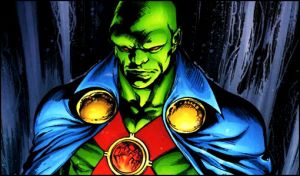 |
Both the fictional and the meta-fictional literature on the Martian Manhunter play his attributes as a stranger. However, in the past, this quality of the character has been overshadowed by other members of the Justice League, the core group where J’onn J’onzz has belonged for decades. For example, Superman, many argue, is also a stranger, and in his case, the last son of Krypton. Superman is an alien, just like the Martian Manhunter, and to some extent, the story of the Martian Manhunter, could be deemed as a copy of Superman's, who existed decades before and was the seminal model for all super heroes. Other characters such as Wonder Woman, Aquaman, the Red Tornado, Hawkman, Hawkgirl, Batman and the Phantom Stranger can also be seen as strangers within the Justice League of America. Wonder Woman is an Amazon princess from a world devoid of males. Aquaman is the ruler of the underwater kingdom of Atlantis. The Red Tornado is a space ghost trapped in the body of a mechanized android. Various versions of Hawkman and Hawkgirl hail from the planet Thanagar. Batman, unlike his fellow Justice Leaguers is a loner and has no super powers. The Phantom Stranger, as his name implies is apart of the Justice league, although invited and welcomed as a full member.
Superman’s story follows that of
Moses where he was sent to Earth from planet Krypton as a baby and learned the mores and the culture of Earth first, before becoming familiar with his Kryptonian heritage. Superman would be a stranger if he were to return to a Kryptonian world. As has been shown in many stories where he visited the preserved Kryptonian city of Kandor, Superman is more a stranger to his own people than a native. His tacit knowledge was gained as an Earthling from Smallville, Kansas. Superman is not a stranger to Earth but a stranger to Krypton. However, except for the city of Kandor, Superman cannot return as a stranger to Krypton. Superman is perpetually tied to Earth, his adopted world but also his formative world. Superman is not a stranger.
Wonder Woman and Aquaman are both from Western society and in the case of the latter, an American citizen. In the case of Wonder Woman, although she remains for long periods in the United States or what she refers to as man’s world, she continually returns to her home, Themyscira. Though in some early stories, she adopted the secret identity of American spy Diana Prince, Wonder Woman is also often deemed an ambassador to man’s world. Ambassadors do not stay permanently with an adopted group. An interesting characteristic of Wonder Woman’s world is that it advocates a kind of Apartheid where women and men are separated. Even though there are men in her greater culture of ancient Greece, they are separated from Wonder Woman’s home village. When Wonder Woman attempts to relate to men related to her group, there is an element of remoteness based on a classification through her gender, which is added to the spatial separation she has to these men. Many of these men, as Greek gods, are in a hierarchy above the Amazons, even if Wonder Woman and her own mother are royalty. Yet, Wonder Woman is neither an immigrant nor a stranger.
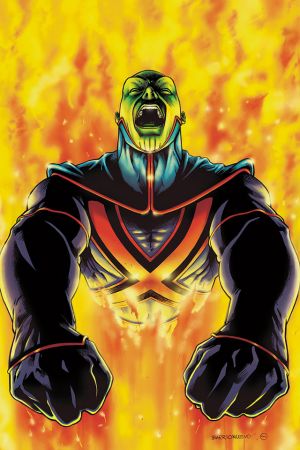 |
Aquaman is often portrayed as being American, sometimes raised in Atlantis and sometimes in the United States. In stories that highlight his American origins, Aquaman is often described by writers as being a stranger to Atlantis. In stories that highlight his Atlantean upbringing, Aquaman is seen more like a dignitary visiting the world above the seas. He is not a permanent immigrant but a visiting ambassador, who much likes Wonder Woman, represents his people in the United States.
Red Tornado appears on the surface to be a stranger much like the Martian Manhunter. In fact, when he was created, it was to occupy the place of Martian Manhunter who was being phased out of the
Justice League of America. Though his soul is alien, the Red Tornado’s body and identity were created to fit in with the Justice League. He was created to be one of them. In fact, his identity as a super hero was conceived within the Justice League of America. That he chose not to betray them, plays on some level on the themes of the stranger being of doubtful loyalty, but not because his pre-existing world views were different than that of his adopted group. Conceived as an artificial man, Red Tornado was just different than others in his group from his conception. Little is known about his world views before he turned into his current configuration. Unlike Martian Manhunter, Red Tornado’s past does not matter as much to the place he occupies today with his group. Red Tornado has aspects of the marginal man, introduced by McLemore to differentiate it from the other type of stranger, the immigrant. Nevertheless, Red Tornado's difference is not marginal. Every member of a group can have differences. Marginality assumes that the member of that group lies outside the normality of the group. When aliens, Amazons and Atlanteans are part of your group, can you argue that you are as marginal just because you are an android?
The Thanagarian versions of Hawkgirl and Hawkman can be deemed strangers just because they are aliens from another world. But as seen in the case of Superman, Wonder Woman and Aquaman, it takes more to be a stranger in the Simmel way. The reason why they moved to Earth is not the basis upon which we can decide whether they are strangers. In some versions of their stories, Hawkman and Hawkgirl moved to Earth to capture a rogue Thanagarian criminal called Byth. After capturing him, they stayed behind to study Earth’s crime-fighting methods. In other versions, separately, Hawkgirl and Hawkman moved to Earth to infiltrate it for a future conquest. In all Thanagarian versions of Hawkman and Hawkgirl, they eventually betray their home world of Thanagar and remain as exiles on Earth.
Where I believe Hawkman does not stand up to the ideal stranger described by Simmel is in his objectivity towards their new adopted world. Politically, the two versions of Hawkman take specific sides in American political debates. The version from the 1960s specifically took on conservative values and clashed with the liberal Justice League member Green Arrow. The 1990s version of Hawkman was portrayed as the opposite. He was highly influenced by the liberal ideals of the American constitution. Instead of being remote observer of Earth and the United States, Hawkman took sides in existing debates.
Hawkgirl’s objectivity in several of her alien representations was more nuanced. She did not adhere to the blunt political views of Hawkman or was portrayed as more discreet than him. She even showed, for example, in the
2000s Justice League cartoon a lot of inner debates and adjustments to the values of Earth versus those of Thanagar. Where, however, she failed to become a Simmelian stranger, is through deficient qualities as a confidante for members of her new group. She remarkably has often been depicted as standoffish.
Batman, in more recent years, has been portrayed as a detached from the Justice League. However, Batman is American and of Earth. His participation in the Justice League, even if remote, determines how the team has been shaped in several incarnations. Batman is more a loner than a stranger. He likes to keep to himself and has reservations about his participation in the League. However, Batman is seen as one of the essential defining character of the Justice League along with Superman. He is not a stranger to that group.
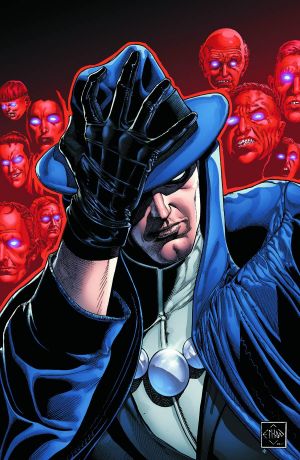 |
The Phantom Stranger, despite his name is closer to a wanderer than a Simmelian stranger. He comes to the Justice League and leaves. He does not belong to the group. His origins are mostly unknown, with at least four conflicting stories, making it difficult to perceive what his core mores and culture are versus what he is confronted with in the Justice League. The Phantom Stranger does not really interact with his fellow Leaguers and there are conflicting accounts of whether he is a member of the Justice League or not.
Literature Review
Since he left planet Mars, in many versions of his story, Martian Manhunter has not returned and remained on Earth. He is not a wanderer just visiting, although in the 1970s, he left Earth to return to his people. He eventually returned to Earth and remained there. After he joined the Justice League, the Martian Manhunter was cast as a stand in for Superman. His stranger attributes were downplayed to highlight his super heroics and similar powers to Superman. He really was a green Superman. It took decades for Martian Manhunter’s core and unique powers to define him as a character. His abilities to shapeshift, turn invisible, move through solid objects, and to read minds have been exploited to a greater extent than his other classic powers such as super strength, super speed, and heat vision. In some recent versions of the character, such as the Justice League cartoon and
Young Justice, his Superman-like powers have completely been written off, except for his power of flight, in order to promote his Martian skills.
Martian Manhunter started as a detective investigating crime and only showing his Martian identity in crises. He remained invisible and unknown to the general population for years. He really was a stranger as John Jones, he was thought to be human but secretly was not. Even on a meta-fictional level, Martian Manhunter was a stranger in comics, as publishers did not know what to do with him for years. Was he an alien detective, a Superman clone or something else? When no answers could be found, he was shelved for years until he was rediscovered by a more creative team of creators who could see his potential.
Analysis
What makes Martian Manhunter a Simmelian stranger is how integral he has been to the Justice League in recent years. His status as a founder has been reignited, although frequently questioned such as in the 1970s when he was exiled from comics and in the latest 52 version of DC Comics’ Justice League where he has been removed from being a founder of the team. In fact in the 52 version, it is continually unclear whether he was a member or not, or just someone who participated in their adventure. In essence, the Simmelian stranger is of the group but often not really a founder of that group. The constant mucking of the Martian Manhunter’s belonging to the Justice League plays on that on a meta-fictional level.
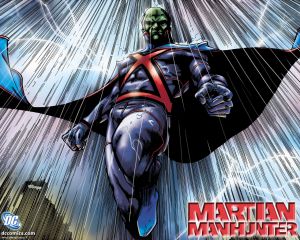 |
Simmel’s stranger is a trader who trades goods unavailable to his new group. The Martian Manhunter has shared good and technology unique to Mars with the Justice League. For example, he frequently uses his telepathy as a communication system between members of the League. Martian Manhunter, of all Justice Leaguers is the one with the most different inner cultural norms. In terms of social mobility, the character has played many roles, such as leader, confidante, advisor, and spymaster. He has played questionable parts in the DC Comics universe, getting his hands dirty, that other characters such as Wonder Woman and Superman and Batman would never venture in. He has been associated with Stormwatch, Amanda Waller, Checkmate and other questionable organizations, outside of the Justice League. He can easily move in and out of those roles, and then come back to play a more traditional super hero role in the Justice League. Martian Manhunter has also been the Justice League member that has been involved the most in the Southern hemisphere traditionally.
In the Justice League, Martian Manhunter is a calm and neutral member whose insight is often sought. Unlike Hawkman, Aquaman or even Superman he does not have partisan opinions and views which colour his judgment. He plays the traditional role of objective judge described by Simmel. The acquisition of information and new knowledge plays an important role in the character of the Martian Manhunter. In many stories, he had to watch hours of televisions to become accustomed to Earth’s mores and culture. This theme was reused with his niece Miss Martian in the Young Justice cartoon series. There, the acquisition of new knowledge was important to her acclimatization to Earth. Martian Manhunter traditionally seeks information about his new world in two ways. First, he shapeshifts into a local human and tries to integrate and virtually spy on other humans to learn from them. The other way Martian Manhunter acquires information, and ultimately knowledge is through telepathy. In both ways, the Martian Manhunter’s abilities to shapeshift and read minds has reinforced his tenure as a confidante to others and as a member of doubtful loyalty in his adopted group.
The Martian Manhunter frequently sees his tacit knowledge challenged by the explicit knowledge he has just acquired through his new group. On Mars, his mind was in continual mind exchange with other Martians. On Earth, it is seen as an intrusion for him to peek into the mind of another individual in order to acquire knowledge. His original values are constantly challenged by newer mores.
Conclusion
It is interesting to see what are the core characteristic and definition that can be given to a comic book character. With Grant Morrison, he approached the Justice League as Greek gods. This interpretation and classification of the team has remained since. DC Comics’ characters are forced to play a role in some greater pantheon where each is an analogue for a Greek deity. I find this restrictive and a lack of imagination. Certainly for some characters this makes sense. Superman is see Zeus, ruling over the other super heroes, Wonder Woman is Hera, Flash is Hermes, Aquaman is Poseidon. While this is tantalizing, it reduces complex characters to mere attributes. Marvel Comics tends to not reduce its characters to mere attributes. Flash, although not a messenger for the Justice League is matched to Hermes, just because of his speed. Aquaman, because he hails from Atlantis and rules over the oceans is seen as Poseidon. Forcing a pantheon on Justice League members also forces clunky reductions on them. Green lantern is supposed to be Apollo. Batman is Hades. Green Lantern, although very cocky is not exactly known for his beauty or his many lovers. Batman lives in the underworld, but is not about death but revenge.
Competing interpretations of DC Comics characters using other models such as Moses and
Jesus Christ for Superman, Aladdin for Green Lantern,
Samson and Ragged Dick for Captain Marvel are, in my opinion richer and bring more nuances. It allows the characters to avoid being forced into one realm, one perspective, such as the Greek Pantheon that DC Comics has had problems discarding ever since it was called upon by Morrison. Characters can evolve under their own myths and associations across a wider spectrum of ideas. Within the Greek pantheon created by Morrison, Martian Manhunter didn’t really have a Greek God analogue.
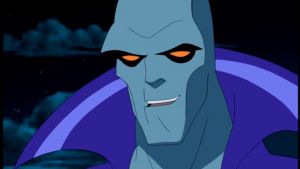 |
Tying Martian Manhunter to Georg Simmel’s stranger allows us to understand a character that was introduced in the context of two genres; the detective story and space aliens from the 1950s. When that mixed origin did not survive recent knowledge about life on Mars, he was changed into a traditional super hero mimicking Superman, then as a spy fighting world conspiracies and then abandoned completely. It is only when the character was brought back that his unique talents and personality started to emerge and for years was seen as an essential member of the Justice League. Since then the character’s appearances in fiction have been based on his interactions with the Justice League. Using the Simmel’s construct of the stranger, all of the disparate ways Martian Manhunter has been defined since his creation start to make sense, while drawing from a strong philosophical cannon instead of being forced into more mechanical and reducing classifications, such as the one offered by the Greek Pantheon. Of all classic characters in the Justice league, the Martian Manhunter is the one who is the closest to the concept of the stranger, as elaborated in 1908 by Georg Simmel.
Work Cited
McLemore, S. Dale. "Simmel's 'Stranger': A Critique of the Concept."
The Pacific Sociological Review 13, no. 2 (1970): 86-94.
Schütz, Alfred. "The Stranger: an Essay in Social Psychology." In
Collected Papers II. Studies in Social Theory, by Alfred Schütz, edited by Arvid Brodersen, 91-105. The Hague: Martinus Nijhoff, 1964.
Simmel, Georg. "The Stranger." In
The Sociology of Georg Simmel, by Georg Simmel, 402-408. New York: Free Press, 1950.
Last Updated: January 17, 2025 - 08:20
